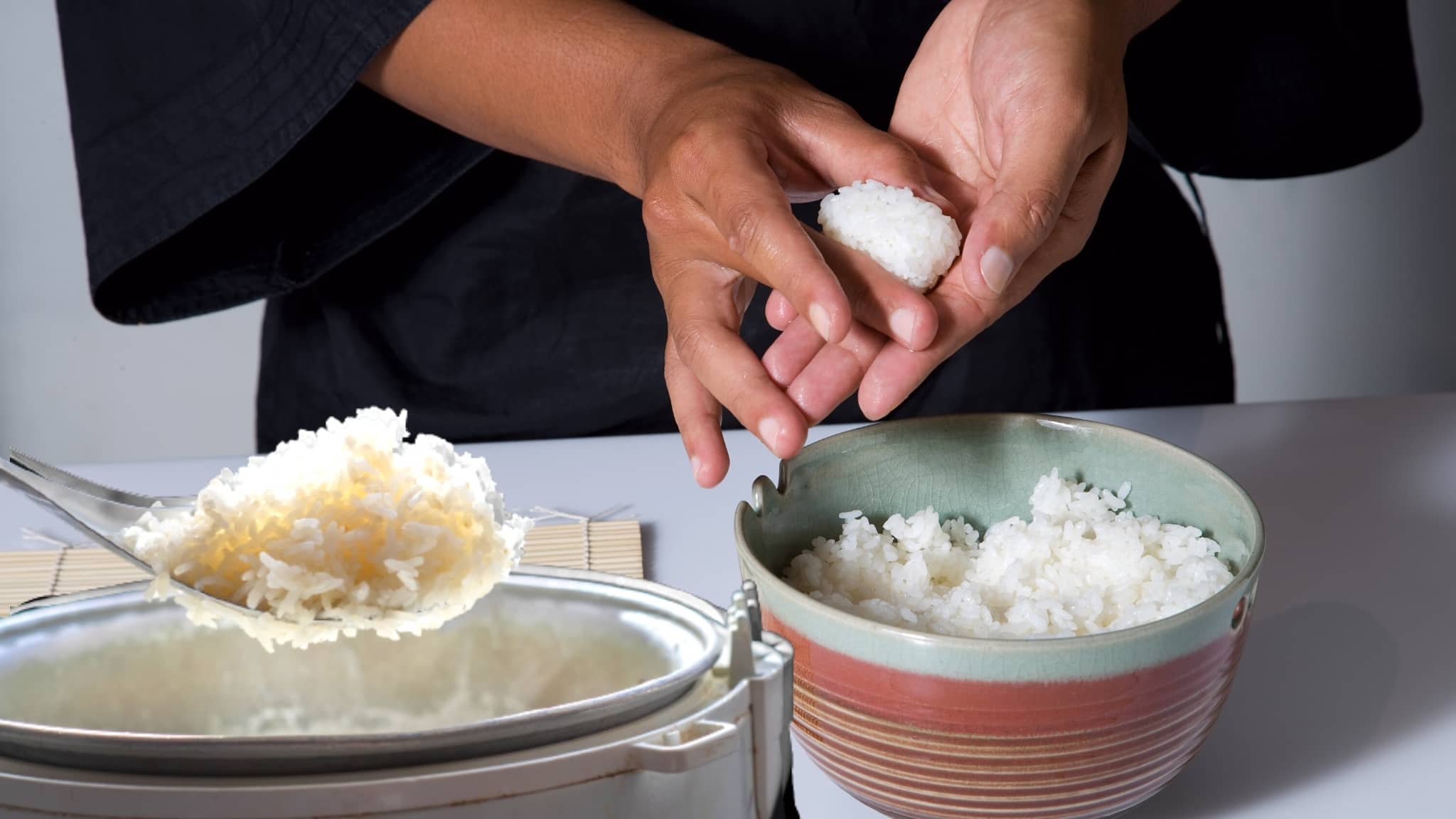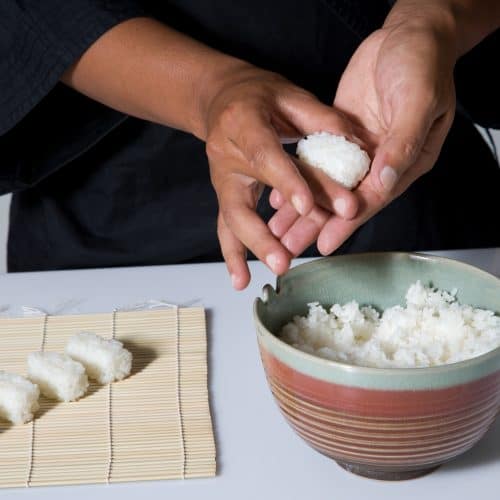How to cook sushi rice without a rice cooker
Are you looking to make sushi at home? Maybe you don’t cook rice too often, especially sushi rice, so you probably don’t own a rice cooker.
But don’t worry; you can make delicious sushi rolls without a rice cooker. So grab a big pot, turn on the stove, and get cooking!
Most non-Asian households don’t own rice cookers since rice isn’t one of the main food staples. So you’re not alone, and you’re totally fine!

Rice is a versatile grain, and there are many ways to cook it. Even if cooking sticky sushi rice seems like a challenge, it really isn’t.
How is cooking sushi without a rice cooker different?
When making sushi rice without a rice cooker, boil the rice in a pot with more than enough water to cover it. Instead of cooking the sushi rice for 20-30 minutes as you would with a rice cooker, you must cook it for approximately 12 minutes on the stovetop. But the challenge of cooking sushi rice without a rice cooker is that you need to stir the rice as it simmers so that it doesn’t get clumpy and instead, takes on that fluffy, sticky texture.
Let’s look a little closer at how to cook perfectly sticky sushi rice without a rice cooker.
The easiest way to cook the sticky sushi rice is on the stovetop in a pot. First, you bring it to a boil, then simmer it.
The key to preparing sushi rice the right way is to follow all the steps, including washing the rice, simmering on low heat, and adding rice vinegar to give it the perfect texture and flavor.
Also read: these are 22 sauces you can’t do without when making rice dishes

Check out our new cookbook
Bitemybun's family recipes with complete meal planner and recipe guide.
Try it out for free with Kindle Unlimited:
Read for freeIn this post we'll cover:
How to cook sushi rice without a rice cooker: full recipe
Since we’re not using a rice cooker, all of the steps below are very important. Follow the recipe closely!
When you cook sushi rice in a rice cooker, it becomes plump, chewy, and sticky. It also absorbs the rice vinegar and gains that perfect sour yet umami flavor.
But when you cook it in a pot on your stovetop, you need to keep mixing and checking the water level until the rice has the desired texture. After all, one of the risks of not cooking the rice in a cooker is that your texture may not be perfect.
Before you can cook the sushi rice, you need to prepare and gather your kitchen utensils and additional ingredients.
In order to get that perfect sticky sushi rice texture, you must use the best sushi rice. I recommend the Nishiki medium grain rice, as it’s been the trusted sushi rice for decades.
If you don’t use sushi rice, it’ll be too mushy or too fluffy. Or the shape and texture can be hard to work with.
For the rice vinegar, I always go for the Marukan seasoned gourmet rice vinegar.
Now let’s see the process for cooking sushi rice without a rice cooker!
In the meantime, check out NOT ANOTHER COOKING SHOW’s video on making sushi rice without a rice cooker:

Sushi rice recipe (without rice cooker)
Equipment
- 1 Large pot with a lid
- 1 Large bowl
- 1 wooden spoon (for mixing)
Ingredients
- 2 cups sushi rice
- 2 ½ glasses water (approximately)
- 4 tbsp seasoned rice vinegar (sushi vinegar)
- 2 tbsp sugar
- 1 tbsp salt
Instructions
Step 1: Wash the rice
- Put the rice in a large pot. Fill with cold water and then immediately drain the water.
- Next, repeat the process and rewash the rice. Rinse and drain.
- With your fingers, stir the rice to make sure any impurities are removed.
- Repeat the washing process 2 more times. The water you throw out must be completely clear. This means the rice is clean.
- Now fill up the pot with water once again and let the rice soak for approximately 30 minutes.
- Drain the water after 30 minutes. Now you’re ready to start cooking.
Step 2: Cook the rice
- Put the rice in the pot and fill with water until it covers the rice well. Don’t cover with the lid yet. Make sure that there's about 20% more water than rice in the pot.
- Bring the rice to a boil, then reduce the heat to low. Make sure to stir continuously so the rice doesn’t get clumpy.
- Now put the lid on and reduce the heat to a minimum. Let the rice cook for about 12-14 minutes, or as directed on the rice packaging.
- Start to check if the water is evaporated after about 12 minutes of cooking time.
- Always check the water because once it evaporates, it takes a matter of seconds for the rice to stick to the bottom and burn. So you have to be very quick to remove the pot from the stove.
- The rice is ready after all the water is evaporated. At this time, you should have only rice in the pot.
- Now take out the rice and put it in a large bowl where you can mix it.
- Tip: If the rice is stuck to the bottom, don’t use those bits at all. It'll make the sushi taste bad.
Step 3: Rice vinegar
- In this step, you need to use seasoned rice vinegar (also called sushi vinegar) and mix it with the rice.
- In your bowl, mix the hot rice with the 4 tbsp of seasoned rice vinegar. Mix very gently and slowly to avoid crushing the rice. Use a wooden spoon because it makes it easier to mix, and wood doesn’t chemically react with sushi rice, which means it doesn’t alter the taste.
- Add in the sugar and salt, and continue mixing.
- Once you’re done mixing, cover the bowl with cling film or a towel and let it cool until you make the sushi rolls.
- Tip: If you find it hard to mix the rice and vinegar, split the rice in the middle first. Then, keep turning in the opposite direction, then switch. Make sure to mix slowly and apply light pressure.
Nutrition
Read more about Sushi vinegar | Homemade recipe + 3 best store-bought vinegars
No rice cooker, no problem!
As you can tell, cooking sushi rice without a rice cooker is pretty simple. You can prep and cook the rice in about 20 minutes.
If you’re not planning on making many rice dishes, you don’t need to invest in a rice cooker. A large pot and your stovetop will do just fine!
The secret to getting that perfect texture is soaking the grains and cooking them until all the water evaporates, but not a minute longer.
Also read: Sushi for beginners | a little history & the best get started guides
Check out our new cookbook
Bitemybun's family recipes with complete meal planner and recipe guide.
Try it out for free with Kindle Unlimited:
Read for freeJoost Nusselder, the founder of Bite My Bun is a content marketer, dad and loves trying out new food with Japanese food at the heart of his passion, and together with his team he's been creating in-depth blog articles since 2016 to help loyal readers with recipes and cooking tips.

